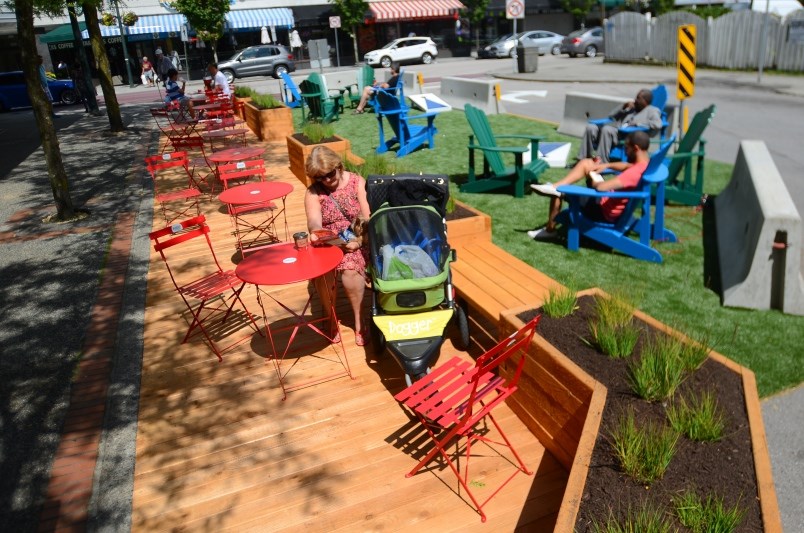Sechelt council has given its approval for a street patio pilot project downtown.
In a report to council on May 20, community planner Marina Stjepovic said the pilot project was requested by the Sechelt Downtown Business Association (SDBA) and district staff were looking for council authorization to “transform a determined stretch of Cowrie Street as a pedestrian-only environment … incorporating street patios and sidewalk sales.”
In a letter to council, SDBA president Paul Legge said the group would like to see a street patio in place from June through September to “allow locals and visitors to utilize public space in a more positive way that people enjoy.”
A graphic included with the letter marks out an area of parking spaces on Cowrie Street between Trail Avenue and Inlet Avenue, near the rainbow crosswalk, as a possible location.
“Adorned with plants and furniture, an enclosed patio will increase the vibrancy to our downtown offering a much needed gathering space which downtown Sechelt currently lacks,” Legge said of the SDBA proposal.
The group VoiceLab also sent a letter to Sechelt council earlier this month suggesting that “downtown Cowrie Street should be closed to vehicle traffic, so that pedestrian space may be expanded [and] parking lots and spaces on Cowrie should be available for use by adjoining businesses.”
Council was supportive of a pilot project that would encompass more than just the SDBA’s proposed patio.
Coun. Alton Toth, and others on council, said the district should take a relatively broad approach and wait to see what ideas business owners bring forward.
Toth said based on what he knows of Canmore, Alberta’s experience with a similar idea, it would be a good fit for Sechelt. “[It] brings so much life into the street. I think that this is a great idea. It's a 21st century idea.”
“I think a project like this is actually going to draw people downtown,” said Coun. Brenda Rowe. “It’s something new and exciting, and it certainly shows that we support our local business and [are] responding to what their needs might be.”
Coun. Janice Kuester said every business should have the opportunity to apply for street space, regardless of the product or service they’re involved in.
“If COVID has taught us anything it’s that we can’t operate in our status quo, we have to look outside the box. How we do business and move through our day life has changed, and we definitely have to look at different opportunities,” she said.
Stjepovic’s report noted that any proposal would require a review and permitting process to ensure it’s feasible and meets basic criteria for issues such as safety, pedestrian and traffic flow, and impact to parking.
Planning department staff told council that at least one application is waiting to move forward and district CAO Andrew Yeates said for the idea to be effective any street patios that get approved would have to be open for the summer period, and that means a streamlined approval process.
“We don’t create another stream of bureaucracy,” Yeates told council. “People are coming up with these nifty ideas to do on sidewalks and [if] we’re going through some protracted process for staff, and then back to council and then back and forth, the summer will be over.”
Coun. Matt McLean said the “number one priority” for considering any applications would be to “make sure that the sidewalks are clear and that people can get by.”
Applications that involve food, beverage or liquor service would also need the OK from Vancouver Coastal Health (VCH) and the province.
The province announced May 22 that it was moving ahead with a fast-track process for approving applications for food-primary and liquor-primary establishments as well as wineries, breweries and distilleries, to temporarily expand their service areas.
The permits will allow only an increase in an establishment’s “service area” and not an increase in occupancy limits.



